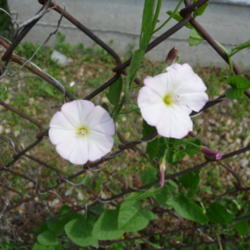
Bindweed (Convolvulus arvensis) is a perennial vine with green, arrow-shaped leaves and 1-inch-wide morning glory-type flowers that may be pale pink or white. Extremely persistent, bindweed produces new plants from seeds and from buds on its roots. Bindweed roots can spread 30 feet from the parent plant. Found throughout North America, bindweed can grow anywhere except in deep shade. Control it by digging, cutting it back to reduce reseeding, or brushing it with a glyphosate herbicide.
Weed Control TechniquesDigging. Weeds that regrow from persistent roots must be dug. Use a spade or digging fork to dig spreading perennials, such as bindweed, Canada thistle, and quackgrass. Start digging a foot away from the plant's center to loosen the soil. Then lift the weed from beneath, which reduces how many root pieces are likely to break off and regrow. Dandelion, dock, and other weeds that grow from persistent taproots can be dug the same way, or you can use a special fork-like tool called a dandelion weeder to pry them up. Dig very large taproots that are difficult to pry loose. In lawns and other places where digging dandelions is not practical, use a sharp knife to slice off the leaves and the top inch or two of taproot at a diagonal angle. Some weeds that are easily pulled when the soil is moist must be dug from dry soil.
Reducing reseeding. Most weeds reproduce primarily from seeds, and the seeds of some weeds can remain viable when buried in the soil for decades. So it's essential to keep weeds from shedding seeds in the garden. Garden weeds that are neglected until they reach seed-bearing age can be lopped off near the soil line with pruning shears, a stout knife, or a string trimmer with a blade attachment. Cutting back perennial weeds again and again not only reduces reseeding, it also forces the plants to use up food reserves stored in their roots. In a garden that has gone hopelessly weedy, mowing it down promptly, raking out the seed-bearing debris, and starting over next year is a big step in the right direction. Mowing regularly helps keep weeds under control in lawns. When mowing lawns where seed-bearing weeds are present, collect the clippings in a bagger and dispose of them in a shady place.
Glyphosate herbicide. It is safer to use a strong herbicide to control a dangerous weed such as poison ivy than to engage in hand-to-hand combat. Mix a small amount of glyphosate herbicide according to label directions, and use a paintbrush to ″paint″ weed leaves on a warm day when rain is not expected for at least 48 hours. Be careful, because spills and splatters also will injure or kill other plants. Ready-to-use glyphosate sprays are another option, but spraying with this chemical should be done only in still weather. A small amount of wind can carry the spray to nearby garden plants. As an extra precaution, surround the weed with a bottomless cardboard box before applying herbicide. Do not use glyphosate near water, and limit your use to dangerous plants, such as poison ivy. Glyphosate works by interfering with photosynthesis, so plants die slowly over a period of several days.
Image courtesy of Plant Stock Photos
 |
 |
 |
 |